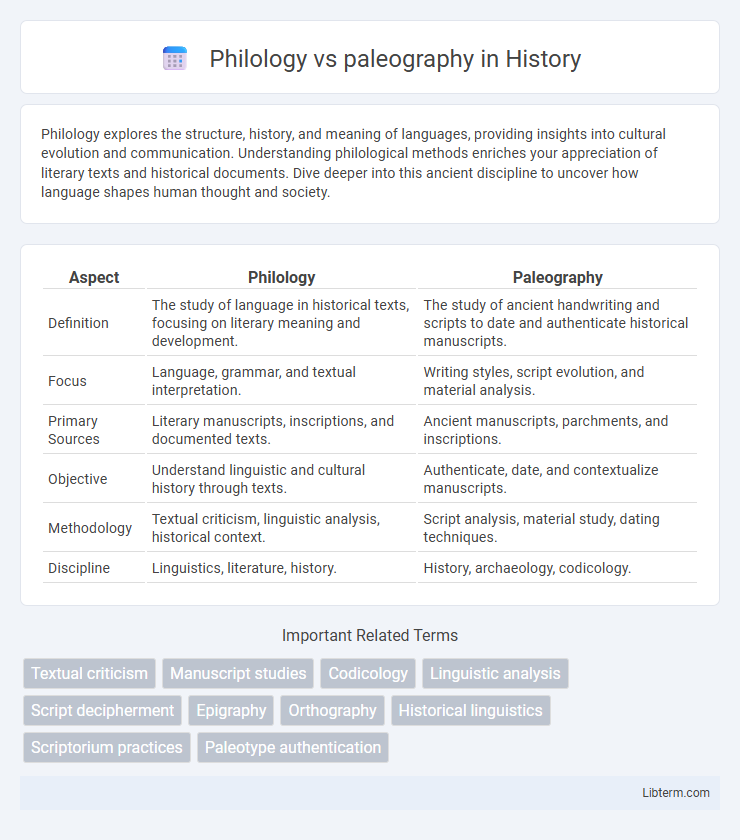Philology explores the structure, history, and meaning of languages, providing insights into cultural evolution and communication. Understanding philological methods enriches your appreciation of literary texts and historical documents. Dive deeper into this ancient discipline to uncover how language shapes human thought and society.
Table of Comparison
| Aspect | Philology | Paleography |
|---|---|---|
| Definition | The study of language in historical texts, focusing on literary meaning and development. | The study of ancient handwriting and scripts to date and authenticate historical manuscripts. |
| Focus | Language, grammar, and textual interpretation. | Writing styles, script evolution, and material analysis. |
| Primary Sources | Literary manuscripts, inscriptions, and documented texts. | Ancient manuscripts, parchments, and inscriptions. |
| Objective | Understand linguistic and cultural history through texts. | Authenticate, date, and contextualize manuscripts. |
| Methodology | Textual criticism, linguistic analysis, historical context. | Script analysis, material study, dating techniques. |
| Discipline | Linguistics, literature, history. | History, archaeology, codicology. |
Introduction to Philology and Paleography
Introduction to philology involves the systematic study of language in written historical sources, emphasizing the development, structure, and meaning of texts over time. Paleography focuses on the analysis and interpretation of ancient handwriting and scripts, essential for understanding, dating, and authenticating historical manuscripts. Both disciplines intersect in examining historical documents, but philology prioritizes linguistic content, while paleography centers on script form and transcription.
Defining Philology: Scope and Methods
Philology encompasses the critical study of language in written historical sources, combining linguistic analysis with literary criticism to interpret texts and understand language development over time. It employs methods such as textual criticism, etymology, and comparative linguistics to reconstruct original meanings and trace linguistic evolution. Unlike paleography, which focuses on the study of ancient handwriting and manuscript dating, philology emphasizes language structure, literary context, and historical linguistics to analyze and preserve cultural heritage.
Understanding Paleography: Focus and Techniques
Paleography concentrates on deciphering and dating ancient manuscripts by analyzing handwriting styles, ink, and material composition, providing crucial context for historical documents. This discipline employs techniques such as script comparison, carbon dating, and digital imaging to authenticate and interpret texts. Philology, in contrast, focuses on the linguistic and literary analysis of texts, studying language evolution, grammar, and meaning rather than the physical characteristics of writing.
Historical Development of Philology and Paleography
Philology, emerging in the Renaissance, evolved through the study of classical texts and linguistic analysis, advancing methodologies for interpreting ancient languages and literature, while paleography developed as the study of ancient handwriting and scripts, focusing on the dating and deciphering of historical manuscripts. The historical development of philology is marked by figures like Friedrich August Wolf who emphasized critical textual scholarship, whereas paleography's growth centered on cataloging and authenticating documents, with origins in medieval script study. Both disciplines converged in the 19th century through archaeological discoveries, enhancing understanding of cultural and historical contexts in textual analysis.
Key Differences Between Philology and Paleography
Philology centers on the study and interpretation of literary texts, analyzing language, grammar, and historical context to understand meaning and evolution, while paleography focuses on deciphering ancient handwriting and scripts to date and authenticate manuscripts. Key differences include philology's emphasis on textual content and linguistic analysis versus paleography's concentration on the physical characteristics of writing, script styles, and orthographic features. Philologists rely heavily on linguistic evidence, whereas paleographers use codicological methods to reconstruct the history of written documents.
Overlapping Areas: Where Philology Meets Paleography
Philology and paleography intersect in the analysis of ancient manuscripts, where philologists interpret the linguistic content while paleographers study the handwriting and script styles to date and authenticate texts. Both disciplines collaborate to reconstruct historical contexts, enhance textual understanding, and preserve cultural heritage by combining language expertise with paleographic evidence. This synergy is crucial in deciphering and validating early documents, enabling accurate historical and literary scholarship.
Importance of Philology in Textual Analysis
Philology plays a crucial role in textual analysis by enabling the comprehensive understanding of language, grammar, and historical context within ancient manuscripts, thereby ensuring accurate interpretation. It involves the study of literary texts, their meanings, and linguistic evolution, which helps reveal cultural and historical insights often missed by paleography's focus on script and handwriting. Philological analysis provides the necessary semantic framework to decode ambiguous passages and understand the author's intent, making it indispensable for authentic textual scholarship.
The Role of Paleography in Manuscript Studies
Paleography plays a crucial role in manuscript studies by enabling the accurate dating and localization of historical documents through the analysis of handwriting styles and script evolution. This discipline aids philologists by providing essential insights into the authenticity, provenance, and historical context of texts, facilitating reliable textual interpretation and restoration. Understanding the development of scripts through paleographic methods deepens knowledge of cultural and linguistic history, complementing the philological study of language and literature.
Modern Applications of Philology and Paleography
Modern applications of philology include digital text analysis, computational linguistics, and the preservation of endangered languages through textual interpretation and translation. Paleography is essential for authenticating historical manuscripts, aiding in the decipherment of ancient scripts, and supporting digital archiving of handwritten documents using AI-driven handwriting recognition. Both fields contribute significantly to cultural heritage studies, historical research, and the development of digital humanities projects.
Conclusion: Choosing Between Philology and Paleography
Choosing between philology and paleography depends on one's focus: philology involves the study of language, literature, and historical texts to understand cultural and linguistic evolution, while paleography concentrates on the analysis and interpretation of ancient handwriting and manuscript materials. Researchers aiming to decode textual meaning, linguistic development, and literary history should prioritize philology. Scholars interested in the physical aspects of manuscripts, script styles, and dating historical documents will find paleography more relevant to their expertise.
Philology Infographic

 libterm.com
libterm.com